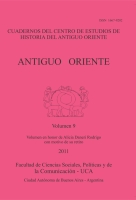Por favor, use este identificador para citar o enlazar este ítem:
https://repositorio.uca.edu.ar/handle/123456789/7461| Título: | Egipto bajo los reyes y jefes de origen libio (Tercer período intermedio) : algunas observaciones respecto de sus prácticas político-ceremoniales Egypt Under the Kings and Chiefs of Lybian Origin: Some Remarks on their Political-Ceremonial Practices |
Autor: | Crespo, Celeste María | Palabras clave: | HISTORIA ANTIGUA; HISTORIA DE EGIPTO; HISTORIA POLITICA; HISTORIA RELIGIOSA; GOBERNANTES | Fecha de publicación: | 2011 | Editorial: | Pontificia Universidad Católica Argentina. Facultad de Ciencias Sociales, Políticas y de la Comunicación. Departamento de Historia. Centro de Estudios de Historia del Antiguo Oriente | Cita: | Crespo, C.M. Egipto bajo los reyes y jefes de origen libio (Tercer período intermedio) : algunas observaciones respecto de sus prácticas político-ceremoniales [en línea]. Antiguo Oriente: Cuadernos del Centro de Estudios de Historia del Antiguo Oriente. 2011, 9 Disponible en: https://repositorio.uca.edu.ar/handle/123456789/7461 | Resumen: | Resumen: Durante el Tercer Período Intermedio (c. 1069–715 a.C.) dinastías de origen libio gobernaron Egipto, a la vez que jefaturas de ese origen también consolidaron centros de poder regional en el territorio egipcio. Tradicionalmente, las prácticas sociopolíticas ejercidas tanto por los jefes locales como por los reyes de origen libio fueron conceptualizadas por la historiografía como la “anarquía libia”, en tanto sinónimo únicamente de ruptura con las propiamente egipcias. Otra interpretación propone que los gobernantes libios ya estaban egipcianizados, producto de su paulatina inserción en las estructuras políticas egipcias. En este sentido, nuestro objetivo consiste en conceptualizar las prácticas introducidas por los libios a partir de una ponderación de las evidencias escritas e iconográficas. A tal fin, en este trabajo identificaremos, por un lado, algunas prácticas político-ceremoniales que sostuvieron los libios en su apropiación de la realeza establecida en Egipto, y por otro, algunas implementadas por los jefes locales libios desde sus centros regionales del Delta. Por cierto, nuestro abordaje presupone la existencia de rupturas, pero también de continuidades y de procesos de acomodación inéditos que, precisamente, le otorgan especificidad histórica a ese período. Abstract: During the Third Intermediate Period (c. 1069–715 BC) dynasties of Libyan origin governed Egypt, while chiefdoms of the same origin also consolidated centers of regional power in Egyptian territory. The sociopolitical practices exercised by both the local chiefs and the kings of Libyan origin were traditionally conceptualized by the historiography as the “Libyan Anarchy,” i.e. as a synonym for the rupture with the Egyptian practices. Another interpretation suggests that the Libyan lords were already Egyptianized, as a product of their gradual insertion into the Egyptian political structures. In this regard, our aim is to conceptualize those practices introduced by the Libyans through an analysis of the written and iconographic evidence. To this end, in this work we will identify, on the one hand, some political-ceremonial practices performed by the Libyans in their appropriation of the Egyptian kingship, and on the other, some practices implemented by the Libyan local chiefs from their regional centers in the Delta. Certainly, our approach presupposes the existence of ruptures, but also of continuities and unprecedented adjustment processes which, precisely, give historical specificity to that period. |
URI: | https://repositorio.uca.edu.ar/handle/123456789/7461 | ISSN: | 1667-9202 | Disciplina: | HISTORIA | Derechos: | Acceso Abierto | Fuente: | Antiguo Oriente: Cuadernos del Centro de Estudios de Historia del Antiguo Oriente. 2011, 9 |
| Aparece en las colecciones: | AO - 2011 vol. 9 |
Ficheros en este ítem:
| Fichero | Descripción | Tamaño | Formato | |
|---|---|---|---|---|
| egipto-reyes-jefes-origen-libio.pdf | 186,01 kB | Adobe PDF |  Visualizar/Abrir |
Visualizaciones de página(s)
621
comprobado en 30-abr-2024
Descarga(s)
812
comprobado en 30-abr-2024
Google ScholarTM
Ver en Google Scholar
Este ítem está sujeto a una Licencia Creative Commons

